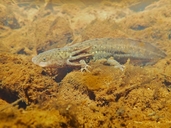|
Ambystoma flavipiperatum Dixon, 1963
Yellow-Peppered Salamander, Ajolote de Chapala Subgenus: Heterotriton | family: Ambystomatidae genus: Ambystoma |
| Species Description: Dixon, J. R. 1963. A new species of salamander of the genus Ambystoma from Jalisco, Mexico. Copeia 1963: 99–101. | |
 © 2023 Axel Hernandez (1 of 8) |
|
|
|
Description When compared to A. rosaceum, A. ordinarium, A. taylori, A. tigrinum, A. granulosum, and A. bombypellum, A. flavipiperatum has considerably more vomerine teeth (average of 70.8 compared to 52 or less). Amybstoma amblycephalum has an average of 70.5 vomerine teeth, but A. flavipiperatum possesses more costal grooves (13) than A. amblycephalum (11), a larger tail to total length ratio (0.44 mm to 0.41 mm) in females, and different coloration (Dixon 1963). In life, these salamanders are black in color with two small yellow spots on each costal fold. There are also many bright yellow spots between the axilla and groin on both sides, and more yellow spots on the lateral sides of the tail. There are no spots on the dorsal surface of the salamanders’ head or limbs. However, there are large yellow spots on the ventral surface of the limbs. The ventrolateral surfaces of the body have an irregular, wide yellow stripe. The throat and chin are a mosaic of slate gray and yellow. From the throat to the cloaca, the ventrum is slate gray and two additional longitudinal, broken, yellow strips are present. In males, the ventral surface of the tail has a yellowish brown line that covers seven-eights of the tail beginning at the vent. In females the ventral surface of the tail is black in females (Dixon 1963). Overall, females a have a slightly longer tail-total length ratio. Females also have darker limbs and venter, and more distinct color pattern. In the same vain, the ventral surface of the tail is black in females whereas the male have a yellow ventral surface on their tail. Females may also lose yellow spotting as they age (Dixon 1963). Distribution and Habitat Country distribution from AmphibiaWeb's database: Mexico
Life History, Abundance, Activity, and Special Behaviors Female specimens contained 128 – 1451 eggs in each ovary depending on their size and maturity. It is believed that females can lay between 2500 – 3000 eggs. The eggs were 1.8 – 2.0 mm in diameter and were similar to eggs of A. rosaceum (Dixon 1963). Males in breeding condition have greatly enlarged and swollen cloacae. The inner lips have large papillae and the sperm ducts were convoluted (Dixon 1963). Individuals are reported to live for 25 years (IUCN 2016). Larva Trends and Threats Its major threats are habitat destruction and fragmentation from smallholder farming. The species is also threatened by water pollution, road construction, human settlements, and introduction of predatory fish. More specifically, in Sierra de Quila, water pollution by visitors and climate change, which has affected rainfall patterns and intensity, has caused a reduction in suitable habitat. However, a local committee in the Area de Proteccion de Flora y Fauna Sierra de Quila, is using the species as an umbrella species to protect clean water. The group is monitoring the stream and reaching out to local landholders about the importance of clean water and this species. Nevertheless, further habitat protection is needed to conserve this species and more genetic research is needed to elucidate the taxonomy of other populations in the Guadalajara region (IUCN 2016). Possible reasons for amphibian decline General habitat alteration and loss Comments Evidence from mitochondrial DNA sequences shows close relationship to some Mexican populations of A. velasci (IUCN 2016). The species epithet refers to its yellow spots. In Latin “flavi” means “yellow” and “piperatum” means “peppered”.
References
Dixon, J.R. (1963). ''A New Species of Salamander of the Genus Ambystoma from Jalisco, Mexico.'' Copeia, 1963(1), 99-101. IUCN SSC Amphibian Specialist Group. (2016). Ambystoma flavipiperatum. The IUCN Red List of Threatened Species 2016: e.T59056A3075883. http://dx.doi.org/10.2305/IUCN.UK.2016-1.RLTS.T59056A3075883.en. Downloaded on 22 March 2017. Originally submitted by: Mauro Hernandez and Jake Lee (first posted 2017-03-25) Edited by: Ann T. Chang, Jarrett Johnson (2023-04-25) Species Account Citation: AmphibiaWeb 2023 Ambystoma flavipiperatum: Yellow-Peppered Salamander <https://amphibiaweb.org/species/3832> University of California, Berkeley, CA, USA. Accessed Nov 12, 2024.
Feedback or comments about this page.
Citation: AmphibiaWeb. 2024. <https://amphibiaweb.org> University of California, Berkeley, CA, USA. Accessed 12 Nov 2024. AmphibiaWeb's policy on data use. |




 Raffaëlli Account
Raffaëlli Account Map of Life
Map of Life